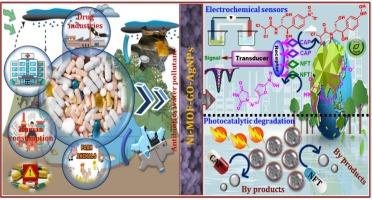Design and fabrication of integrated ternary hybrid nanocomposites based on Ni-MOF/GO/AgNPs: A bi-functional catalyst for simultaneous sensor detection and photocatalytic degradation of dual nitroaromatic antibiotics
IF 9.7
1区 化学
Q1 CHEMISTRY, PHYSICAL
引用次数: 0
Abstract
Antibiotic residues may cause severe health issues at low concentrations. Detecting nitroaromatic-based antibiotics in aqueous and soil environments is crucial to human health; however, it poses a serious challenge to degradation and sensor detection. In order to address these issues, we developed Ni-MOF hybrid composites embedded with graphene oxide (GO) and silver nanoparticles (AgNPs) to generate rapid and simultaneous electrochemical sensors and the catalytic degradation of nitrofurantoin (NFT) and chloramphenicol (CAP). Hybrid materials were synthesized using both solvothermal and ultrasonic stirrer-assisted routes, and their components were characterized by spectral, morphological, and electrochemical studies. In the fabricated electrochemical sensors, CAP and NFT can be detected individually and simultaneously with distinct peak separations even at fourfold higher concentrations. Electrochemical sensors based on CAP and NFT provide excellent performance, exhibiting wide linearity ranges of 0.00025–800 μM and 0.0005–750 μM, sensitivity of 15.56 μA μM−1 cm−2 and 12.85 μA μM−1 cm−2, and limits of detection (LOD) of 0.057 nM and 0.161 nM (S/N = 3). Interference-free characteristics surpass interference with amino acids, proteins, structurally similar antibiotics, biomolecules, and metal ions, and have outstanding sensor stability and reproducibility. The practicability of real samples of turbid milk, effluent water, commercial drugs, and colored bio-fluid urine samples was examined and recovery was 96.34–99.56 % and the relative standard deviation (RSD) was 1.02–2.07 %. Moreover, Ni-MOF-GO-AgNPs composites are key catalysts for degrading CAP and NFT, exhibiting 71.24 % and 96.53 % degradation within 70 and 75 min, and displaying superior stability and reusability. Finally, advances in sensors and catalytic degradation represent significant progress in the fight against antibiotic residue pollution.

基于Ni-MOF/GO/AgNPs的集成三元杂化纳米复合材料的设计与制备:一种双功能催化剂,用于同时传感器检测和光催化降解双硝基芳香抗生素。
抗生素残留在低浓度下可能导致严重的健康问题。在水和土壤环境中检测硝基芳香族抗生素对人类健康至关重要;然而,它对退化和传感器检测提出了严峻的挑战。为了解决这些问题,我们开发了嵌入氧化石墨烯(GO)和纳米银粒子(AgNPs)的Ni-MOF杂化复合材料,以产生快速、同步的电化学传感器,并催化降解呋喃醌(NFT)和氯霉素(CAP)。采用溶剂热法和超声搅拌法合成了杂化材料,并对其成分进行了光谱、形态和电化学表征。在制造的电化学传感器中,即使在四倍高的浓度下,CAP和NFT也可以单独和同时检测到明显的峰分离。基于CAP和NFT的电化学传感器具有良好的性能,线性范围为0.00025 ~ 800 μM和0.0005 ~ 750 μM,灵敏度分别为15.56 μA μM-1 cm-2和12.85 μA μM-1 cm-2,检出限分别为0.057 nM和0.161 nM (S/N = 3)。无干扰特性超越了对氨基酸、蛋白质、结构相似的抗生素、生物分子和金属离子的干扰,具有出色的传感器稳定性和可重复性。对浊乳、出水、商品药品和有色生物液尿样的实际样品进行了实用性检验,回收率为96.34 ~ 99.56%,相对标准偏差(RSD)为1.02 ~ 2.07%。此外,Ni-MOF-GO-AgNPs复合材料是降解CAP和NFT的关键催化剂,在70 min和75 min内降解率分别为71.24%和96.53%,并具有良好的稳定性和可重复使用性。最后,传感器和催化降解的进展代表了对抗抗生素残留污染的重大进展。
本文章由计算机程序翻译,如有差异,请以英文原文为准。
求助全文
约1分钟内获得全文
求助全文
来源期刊
CiteScore
16.10
自引率
7.10%
发文量
2568
审稿时长
2 months
期刊介绍:
The Journal of Colloid and Interface Science publishes original research findings on the fundamental principles of colloid and interface science, as well as innovative applications in various fields. The criteria for publication include impact, quality, novelty, and originality.
Emphasis:
The journal emphasizes fundamental scientific innovation within the following categories:
A.Colloidal Materials and Nanomaterials
B.Soft Colloidal and Self-Assembly Systems
C.Adsorption, Catalysis, and Electrochemistry
D.Interfacial Processes, Capillarity, and Wetting
E.Biomaterials and Nanomedicine
F.Energy Conversion and Storage, and Environmental Technologies

 求助内容:
求助内容: 应助结果提醒方式:
应助结果提醒方式:


